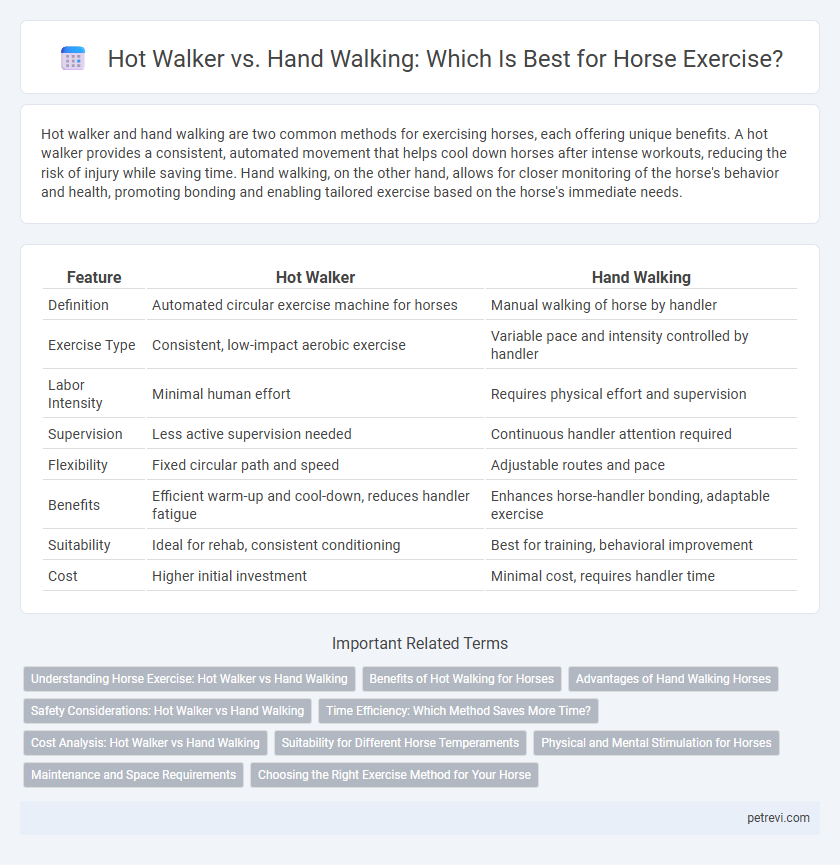Hot walker and hand walking are two common methods for exercising horses, each offering unique benefits. A hot walker provides a consistent, automated movement that helps cool down horses after intense workouts, reducing the risk of injury while saving time. Hand walking, on the other hand, allows for closer monitoring of the horse's behavior and health, promoting bonding and enabling tailored exercise based on the horse's immediate needs.
Table of Comparison
| Feature | Hot Walker | Hand Walking |
|---|---|---|
| Definition | Automated circular exercise machine for horses | Manual walking of horse by handler |
| Exercise Type | Consistent, low-impact aerobic exercise | Variable pace and intensity controlled by handler |
| Labor Intensity | Minimal human effort | Requires physical effort and supervision |
| Supervision | Less active supervision needed | Continuous handler attention required |
| Flexibility | Fixed circular path and speed | Adjustable routes and pace |
| Benefits | Efficient warm-up and cool-down, reduces handler fatigue | Enhances horse-handler bonding, adaptable exercise |
| Suitability | Ideal for rehab, consistent conditioning | Best for training, behavioral improvement |
| Cost | Higher initial investment | Minimal cost, requires handler time |
Understanding Horse Exercise: Hot Walker vs Hand Walking
Hot walkers provide consistent, automated exercise for horses, promoting muscle relaxation and circulation without requiring human effort, which makes them ideal for post-workout cooldowns. Hand walking allows for tailored exercise intensity and interaction, improving a horse's mental stimulation and enabling early detection of health issues through close observation. Understanding these benefits helps horse owners choose between mechanized efficiency and personalized care in exercise routines.
Benefits of Hot Walking for Horses
Hot walking offers precise, controlled cooling down of horses after rigorous exercise, reducing muscle stiffness and preventing lactic acid buildup more effectively than hand walking. Its consistent, gentle motion promotes blood circulation and aids in faster recovery, enhancing overall equine performance. Specialized equipment ensures safety for both horse and handler, making hot walking a preferred method in many professional equestrian settings.
Advantages of Hand Walking Horses
Hand walking horses offers direct control over movement, improving safety during rehabilitation and preventing injury by allowing close monitoring of the horse's gait and behavior. It promotes better mental engagement and trust between handler and horse, enhancing the animal's responsiveness and relaxation. This exercise method also enables customized pacing and direction adjustments, which support specific recovery or fitness goals more effectively than mechanical hot walkers.
Safety Considerations: Hot Walker vs Hand Walking
Hot walkers provide consistent, controlled exercise for horses, reducing the risk of injury by minimizing human error and fatigue during handling. Hand walking allows for more personalized attention and immediate response to a horse's behavior but requires experienced handlers to ensure safety. Choosing between a hot walker and hand walking depends on the horse's temperament, handler skill level, and the specific exercise goals to prevent accidents and maintain equine health.
Time Efficiency: Which Method Saves More Time?
Hot walkers provide a time-efficient solution by allowing multiple horses to be exercised simultaneously without constant human attention, reducing total exercise time. Hand walking requires one-on-one interaction, consuming significantly more time per horse but offering personalized control and observation. For barns managing large horse populations, hot walkers optimize labor and streamline exercise routines, while hand walking suits smaller operations needing individualized care.
Cost Analysis: Hot Walker vs Hand Walking
Hot walkers typically involve an initial investment ranging from $3,000 to $8,000 plus ongoing maintenance costs, whereas hand walking incurs minimal direct expenses but requires continuous time and labor, impacting labor costs significantly. Studies show that for stables with multiple horses, hot walkers reduce staffing needs and long-term labor expenses by automating exercise routines. Evaluating cost-efficiency depends on horse population size and labor availability, with hot walkers offering scalability and consistent exercise at higher upfront cost compared to the low-cost, labor-intensive hand walking method.
Suitability for Different Horse Temperaments
Hot walkers provide consistent, low-impact exercise ideal for high-energy or anxious horses needing controlled movement to prevent overexertion. Hand walking allows for tailored interaction, benefiting nervous or inexperienced horses by offering direct guidance and responsiveness during exercise. Selecting between hot walker and hand walking depends on the horse's temperament, training level, and specific exercise requirements to optimize physical and mental well-being.
Physical and Mental Stimulation for Horses
Hot walkers provide consistent, low-impact physical exercise that promotes muscle relaxation and improves circulation in horses, especially beneficial after intense workouts. Hand walking offers personalized mental stimulation through varied environments and direct human interaction, encouraging cognitive engagement and reducing stress behaviors. Combining both methods delivers optimal physical recovery and mental well-being, enhancing overall equine health.
Maintenance and Space Requirements
Hot walkers require minimal space and enable multiple horses to exercise simultaneously, making them ideal for efficient maintenance routines. Hand walking demands more time and dedicated personnel but offers personalized control and monitoring of each horse's condition. Both methods contribute to maintaining muscle tone and joint flexibility, yet hot walkers optimize space usage in confined barn areas.
Choosing the Right Exercise Method for Your Horse
Choosing the right exercise method for your horse depends on its specific needs, condition, and workload. Hot walkers provide consistent, low-impact movement ideal for cooling down or warming up horses while reducing human labor, whereas hand walking allows for personalized monitoring and varied pace adjustments targeting mental engagement and muscle conditioning. Evaluating the horse's temperament, fitness level, and recovery requirements ensures optimal benefits from the selected exercise approach.
Hot Walker vs Hand Walking for Horse Exercise Infographic

 petrevi.com
petrevi.com